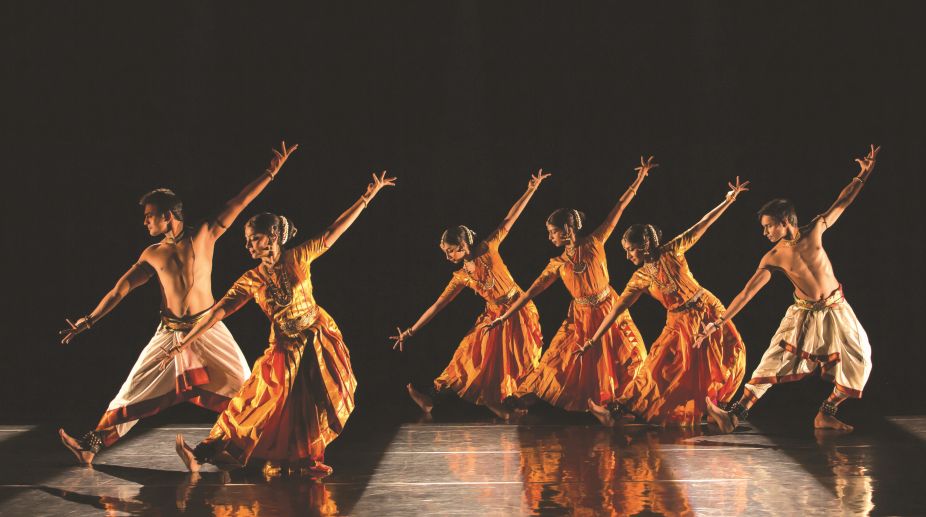Gehlot claims no anti-incumbency against Congress govt
Rajasthan CM claims to have implemented all major welfare schemes and that these schemes have been percolating benefits for the people.
Navarasa Performing Arts Festival in Jaipur presented a mesmerizing choice of classical and contemporary dance and music traditions. A review by Manjari Sinha

Navarasa Performing Arts Festival.
The Navarasa Performing Arts Festival of Jawahar Kala Kendra, Jaipur, a nine- day extravaganza of the choicest performances in theatre, classical and contemporary dance and musical traditions ~ from classical to folk, Sufi and fusion ~ took a thunderous start with the fabulous performance of Dhamal, a celebration of drumming traditions of India, curated and directed by the renowned percussionist Aneesh Pradhan.
It was a delight to see dozens of talented drummers from various parts of India, coming together to weave a tapestry of rhythm grounded in melody and song texts. The vibrant voice of Shubha Mudgal added extra charm to its splendour.
This was followed by Thari ~ the Loom, the path-breaking dance production of Padma Shri and the SNA Awardee Bharatanatyam dancer-choreographer Malavika Sarukkai; a contemporary dance production Bhinna Vinyas by Attakkalari; classical music concerts of morning ragas by Jayateerth Mevundi and Niladri Kumar; brilliant theatre productions like Ismat Apa ke Naam, directed by Naseeruddin Shah, where his wife Ratna Pathak Shah and daughter Heeba Shah also acted; Ek Khwab Sa, an adaptation of Shakespeare’s Midsummer Night’s Dream, directed by Atul Kumar; Sakkar ke Paanch Dane, directed by Manav Kaul; Mahadev Bhai directed by Ramu Ramanathan; Elephant in the Room by Yuki Elias; and many more attractions.
Advertisement
The festival concluded with an audio-visual treat by Rajasthan Roots Caravan with more than 30 Rajasthani musicians and artists on stage exploring the rich cultural heritage of Rajasthani folk traditions.
The well-conceived and imaginatively choreographed Thari the Loom of Malavika, which was inspired by the weaving of Sari on loom, explored the artistic relationship of the dancer and the weaver and the common concepts they shared working through space, proportion, alignment, symmetry, coordination, rhythm and designs.
The analogy takes shape from the very beginning, when the sound of loom is alternated with the mnemonics of Mridangam that establishes the pace of the rhythm for the dancers to play with the spinning wheel with colourful threads creating magnificent designs of melody and rhythm in space.
As a preface to dance, Malavika had shared the memory of her trip to Kanchipuram and how watching the weaving of the Kanjivaram Saris, the concept of this magnificent production emerged from the sounds of loom that created images of music, dance and poetry.
“I heard the divine flute of Krishna creating the designs, colours and the passionate yearning of Radha…,” she stated. All this was translated into the language of dance with sensitivity and excellence.
Through the Aaroh-Avroh (ascending and descending orders of notes) of Shankarabharanam and the permutations and combinations of Swaras and Tala one could visualise the weaving of a Sari with different designs, where the tala was constant and the changing Swaras changed the patterns of the Sari being woven.
There were the Ganga-Jamini borders on the two sides of the Sari depicted by group of dancers on both sides and a solo by Malavika, where designs of Krishna playing the divine flute under the Kadamba tree to the poetry “Krishna Tamal taran bhuj sasha…” and “Bansi Vanshivat Kanha bajawat…” composed in raga Khamaj.
There were beautiful motifs of parrot and Mayura, where Muruga comes on his Wahan, the peacock and the Hamsa where Saraswati is depicted in raga Durga. The stately borders of the Sari, like the two rivers Ganga and Kalindi, speak of the larger idea and become the metaphor of life itself.
The Sari reaches the Pallu, giving the Mantra “live life to the full”, celebrated the rich designs with the vibrant Tillana in Ragamalika. Gradually the Hamsa tuned to the swaras of raga Hamsadhwani, reverses into Soham, reaching the Atma to Paramatma and the production to its philosophic climax.
The mesmerising dance production Thari the Loom was conceived and choreographed by Malavika herself with the creative collaboration of Sumantra Ghoshal. Music and sound designs by Sai Shravanam and dancers along with Malavika were Jyotsna jagannathan, Aruna B, Shreema Upadhyaya, Adithya P V Nidhag Karunad BM.
Bhinna Vinyasa, the contemporary dance production of Attakkalari that combined movement and the digital art under the artistic direction of Jayachandran Palazhy was choreographed by himself.
The unique movement vocabulary encapsulating the essence of Indian traditions and complex contemporary experiences were woven with layered visual images and the surrounding sound of multi-phonic soundscapes.
An exquisitely-trained team of chiseled dancers and perfect synchronisation made the well-rehearsed flawless production a memorable experience, the audience had never savoured before.
Advertisement